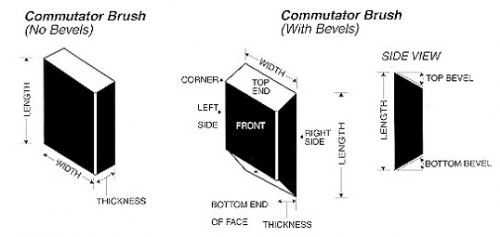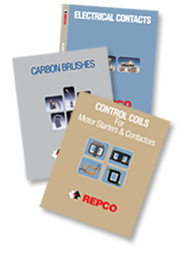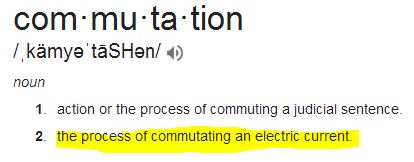
- Electrical Contacts
Electrical Contacts
- Carbon Brushes
Carbon Brushes : Brush Reference
- Control Coils
Control Coils
- Other Contactor Parts
- More
- Search
- Auxiliary Contacts
Auxiliary Contacts
- Shunts
Shunts
- Springs
Springs
- AC Contactors & Starters
AC Contactors & Starters
- DC Contactors
DC Contactors
- Drives
Drives
- Fuses
By: David Howard | G+
What is a carbon brush?
 A carbon brush is a component used to conduct electrical current between the stationary and rotating parts of a motor. In a generator or motor, the commutator rotates on a shaft and the fixed carbon brush rides on it to permit the flow of electricity and complete a circuit.
A carbon brush is a component used to conduct electrical current between the stationary and rotating parts of a motor. In a generator or motor, the commutator rotates on a shaft and the fixed carbon brush rides on it to permit the flow of electricity and complete a circuit.
Brush History
Originally, brushes were made of wire and looked like standard wire brushes. However, the wire brushes tended to wear away the commutator and suffered other run-time issues. The introduction of graphite provided brushes that allowed a more uniform shift of current between commutator segments. Graphite carbon brushes also wear, sparing the commutator. Moreover, the inclusion of special additives in the graphite can help lubricate the connection and the graphite is generally tailored to suit specific operational needs.
Carbon’s (i.e., graphite) flexibility
Carbon brushes are available in four main grade categories: carbon graphite, electrographitic, graphite, and metal graphite. Material types are matched to the demands of the motor or generator as well as the operational environment. Brushes are customized based on dimensions, bevels, seating, shunts and terminals, plates and hard tops, and other special features. Repco provides an excellent Carbon Brush Reference on our website and of course we’re always happy to answer questions by telephone or email.Carbon Brush Grade Choices for Electrical Motors
Carbon brush grades fall under four main categories based on the manufacturing procedures, the types of carbons and other ingredients. The types of brushes are: carbongraphite, electrographite, graphite and metal graphite.
Carbon GraphiteCarbon graphite brushes for electrical motors are among the oldest carbon brush types. They are made of high strength material, but are generally limited to lower current densities on older, slower speed machines. High friction with this type of material makes it unsuitable for present day use on commutators.
Electrographitic Carbon Brushes
Strength and density distinguish electrographitic carbon motor brushes. This is due to the makeup of raw materials that go into making these brushes. The outcome is superior commutating ability, performance at high temperature/low humidity settings and as a result, longer life. Treatments can allow electrographitic materials to operate well in a variety of contaminated environments.
Graphite Carbon Brushes
Graphite brushes are layered with graphite bonded with resin to form a layered brush material. Their controlled filming and excellent riding qualities on both commutators and slip rings characterize these graphite brushes. The fast filming properties of graphite brushes is beneficial in protecting the commutator or slip ring during operation in contaminated atmospheres. Their low absorption and higher density are valuable in reducing commutator threading found in contaminated environments.
Metal Graphite Carbon Brushes
Metal graphite carbon brushes for electrical motors are often made from natural graphite and fine metal powders. Copper is the most common, but silver, tin and lead are sometimes used. Metal graphite brushes are ideal for many applications due to low resistivity. Metal graphite brushes are used on commutators of plating generators that have low voltage and high brush current densities. They operate on rings of wound rotor induction motors where high brush current densities are also found. Metal graphite brushes are used with grounding brushes because of their low contact drop.
Cross Reference for Replacement Carbon Motor Brushes
Chooses the right replacement carbon brush using REPCO’s Carbon Brush Cross Reference.
Types of Carbon BrushesThe term “carbon brush” appeared in electrical engineering history with the change to materials actually made from copper wire, which looked like a brush, to graphite and carbon. Carbon brushes have been evolving for decades. Today, they remain indispensable hardware for DC electrical machines.
Carbon Brush Designs
Solid, one-piece carbon brushes: Solid brushes are the simplest type of brush used on the most basic of machines with little or no electrical and/or mechanical considerations.
Fractional HP brushes: These carbon brushes are also called "spring-loaded" because of the attached spring used to load the carbon in the brushholder. Most of these applications are one piece, however, FHP brushes can also be split.
Split Carbon Brushes: Split bushes are designed by bringing together 2, 3, or more carbon sectors into one unit, resulting in optimal electrical and mechanical contact. Splitting the brush allows for more electrical contact points between the brush surface and commutator and evenly distributed pressure or 'riding'capacity. The carbons can be held together by a riveted clip, however, in most modern applications, they are glued to a rubber hard top.
Carbon Brush Commutation
Brush grades should be chosen by considering various things, like atmospheric conditions, for the best commutation. Commutation (commuting current to complete the circuit) occurs when two or more carbon brushes contact the commutator. For further information on brush grades, see “Replacing Carbon Brushes for Electric Motors”.
How to Troubleshoot Carbon Brushes
The main function of a carbon brush is to conduct current to the revolving motor commutator. In order for the brush to be able to do its job, it needs the help of other associated components in the brush rigging, commutator surface and surrounding environment. Brushes need to have good intimate contact with this moving commutator in order to give adequate life and spark free performance.If brush performance is not to your satisfaction, there are things you can check:- Check any outside contributing factors like machine vibration, over or light loaded, contaminated air supply or insufficient motor ventilation.
- Check the condition of the commutator and filming. Compare filming to a check chart.
- Check stator and coil poles. Are they properly connected?
- Check commutating and main coils.
- Check the insulation resistance.
- Check all of the brushes:
- All the same grade, fully seated, not burned, cracked or too short.
- Electrical neutral properly adjusted.
- Free to move within the brush holder, not sticking, no loose shunts or loose terminals.
- Minimal brush vibration.
- Proper and equal spring force.
- Equally spaced circumferentially around the commutator within .050".
- Brush holders properly spaced.
- No frayed shunts or evidence of current being passed thru the spring or brush holder.
- Proper current density for that brush grade.
For proper spring pressure, see the chart below.Class of ApplicationBrush PressureGeneral Industrial2 to 4 lb/in2 (13.8 to 27.6 kPa)Mill-type Motors3 to 5 lb./in2 (20.7 to 34.5 kPa)Railway Service3.5 to 9 lb/in2 (24.1 to 62.1 kPa)
Original OEM or Repco Replacement Carbon Brushes Repco offers original OEM carbon brushes as well as our own Repco lower-cost alternatives. And similar to our electrical contacts, Repco carbon brushes are guaranteed to match the OEM’s brush in fit, form, and function.
Contact Repco Today at 856-762-0172 For Carbon Brushes.
International: 856-762-0172
Domestic: 800-822-9190
Literature Request Or Download
Click here to download or browse our Electrical Contact, Carbon Brush, or Control Coil catalogs online.

Repco
100 Sonwil Drive
Buffalo NY 14225Repco Quick Contact
We are excited to announce that REPCO has merged with USA Industrials.
For all inquiries, please contact us at service@usaindustrials.com or give us a call at 800-822-9190.
We appreciate your understanding and look forward to serving you better with our expanded capabilities.
- Carbon Brushes
